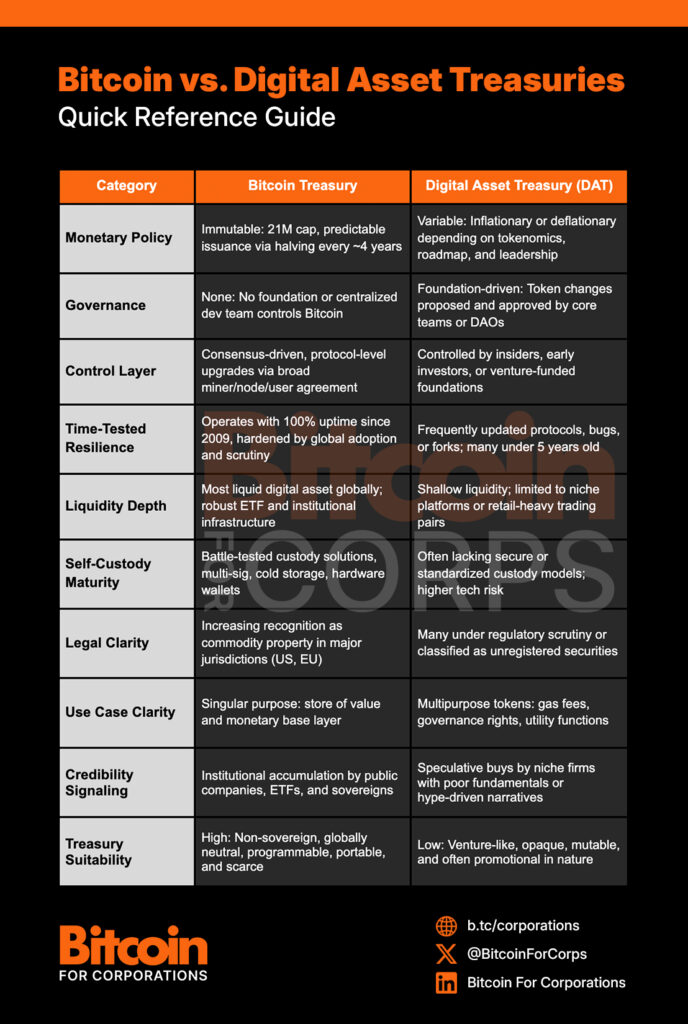Bitcoin Magazine

The DAT Delusion: Why Only Bitcoin Belongs on Corporate Balance Sheets
As Bitcoin adoption by public companies accelerates, imitators are inevitable. The latest trend? DATs — “Digital Asset Treasuries” — which seek to replicate the success of Bitcoin treasury companies by allocating reserves to altcoins like Ethereum or Dogecoin.
From the outside, the surface-level pitch might seem similar: acquire a digital asset, move early, build a treasury strategy, issue equity or dehttps://bitcoinmagazine.com/bitcoin-for-corporations/how-bitcoin-reduces-counterparty-risk-in-corporate-treasury-strategybt, and attempt to capture long-term upside and reflexive flows. But beneath the surface, the comparison collapses.
In recent months, several companies have made headlines for pivoting to DAT models:
These moves aren’t just risky — they reveal a fundamental misunderstanding of what makes Bitcoin uniquely suited to serve as a treasury reserve asset.
Bitcoin is not a tech platform or a product roadmap. It is money — purpose-built, neutral, leaderless, and maximally conservative in its evolution. Its rules are set in stone, its issuance schedule immutably locked, and its design fiercely resistant to change.
Altcoins like Ethereum or Dogecoin, by contrast, are better understood as venture-stage software projects masquerading as money. They are:
From a capital stewardship perspective, this is the difference between:
One is purpose-built for value preservation. The other is a proxy for early-stage risk.

A corporate treasury’s role is not to chase yield — it is to preserve and grow shareholder value over long durations. Public companies are rewarded for resilience, discipline, and clear capital frameworks that hold up across cycles.
Bitcoin’s design aligns with this. Its properties reward conviction over time:
Altcoins invert this logic. They:
This mismatch creates tension for treasuries. The longer you hold a token, the more governance, execution, and regulatory risk you accrue. It becomes harder — not easier — to defend the allocation.
Bitcoin, by contrast, becomes easier to justify over time. It’s the only digital asset where deeper holding reduces—not increases—tail risk.
For public companies, capital strategy must prioritize durability, auditability, and market trust. Allocating to altcoins introduces risks that are antithetical to those goals.
Building a corporate treasury on top of tokens with malleable rules, weak settlement assurances, and governance opacity is not bold — it’s reckless. Bitcoin is the exception not just because it came first, but because its architecture is the only one built to last.
Public companies that adopt Bitcoin are not making a bet on crypto. They’re upgrading the foundation of their capital structure with an asset that is:
Bitcoin’s uniqueness isn’t ideological — it’s structural. And that structure is what enables it to serve as a modern balance sheet anchor in a time of currency volatility, debt saturation, and institutional distrust.
Disclaimer: This content was written on behalf of Bitcoin For Corporations. This article is intended solely for informational purposes and should not be interpreted as an invitation or solicitation to acquire, purchase or subscribe for securities.
This post The DAT Delusion: Why Only Bitcoin Belongs on Corporate Balance Sheets first appeared on Bitcoin Magazine and is written by Nick Ward.
Also read: ABToken lança Manual de Boas Práticas para a Tokenização de Ativos Financeiros e Valores Mobiliários